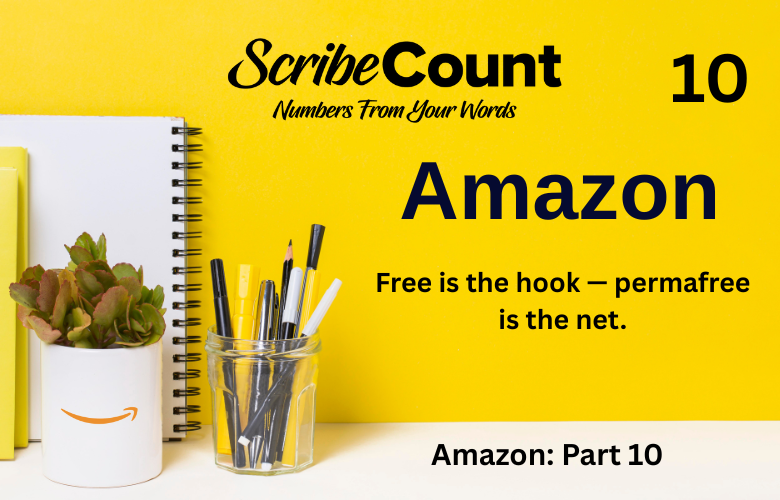How to Use Permafree Books to Build Your Audience on Amazon (with ScribeCount)
Meta Information
Imagine this: Your very first book is up on Amazon, and it’s priced at $0.00. You’re not earning a cent from it. Sound like a rookie mistake? Not so fast. That intentional zero-dollar price tag is what we call Permafree, and when used smartly, it’s one of the most powerful marketing tools in your indie author toolbox.
This guide is for new self-publishing authors who want to understand the what, why, and how of making their book permanently free on Amazon — with all the step-by-step details you need. We'll also explain how this strategy interacts with keywords, subtitles, and the Amazon algorithm, and how tools like ScribeCount can help you measure whether it’s actually working.
By the end, you’ll know how to:
Set your book to free on Amazon (yes, there’s a trick!)
Use a permafree book to market your other titles
Keep track of your free vs. paid performance with ScribeCount
Let’s dive in.
What Is a Permafree Book?
A Permafree book is exactly what it sounds like — a book that is permanently listed as free on digital storefronts like Amazon, Apple Books, Kobo, and Barnes & Noble. It’s most often used as the first book in a series to give readers a no-risk entry point.
This is a classic “lead magnet” strategy in the world of indie publishing. You give away one book in exchange for reader attention, with the goal of turning browsers into loyal fans. When readers enjoy your free book, they're more likely to buy the next one.
If your book has a solid subtitle, smart keywords, and good category placement, Amazon will continue recommending it even while it’s free — especially if it’s part of a series.
Why It Matters
Permafree is particularly powerful for:
First-in-series hooks
Newsletter building
Driving reviews
Getting BookBub Featured Deals (free tier)
But beware: Amazon doesn’t let you simply mark your Kindle book as free. There’s a workaround — and we’ll walk you through it.
A Quick History of Free Books on Amazon
Once upon a time (circa 2012), free books exploded thanks to KDP Select giveaways and sites like Pixel of Ink. The results were bananas: authors woke up to 50,000 downloads overnight. Those days are long gone.
Today, free still works, but more strategically. Instead of temporary free promotions, permafree is about long-term discovery.
Even BookBub, one of the top book promo services, has embraced free books as a permanent strategy — especially for thrillers, fantasy sagas, and steamy romance series.
Three Real-World Examples
Thriller: J.D. Kirk’s A Litter of Bones is free and anchors a long-running detective series.
Fantasy: Lindsay Buroker’s The Emperor’s Edge (Book 1) is permafree and leads into a 9-book series.
Romance: Kristen Ashley’s Rock Chick is a permafree gateway to her beloved Rock Chick series.
These authors use the free first book as a sales funnel to bring readers into a larger world.
How to Make Your Book Free on Amazon
Here’s the catch: Amazon KDP does not let you set your ebook to $0.00. The lowest it allows is $0.99 — unless you price-match from another retailer. Here’s how to do it:
Step-by-Step Instructions
1. Publish Wide First
Skip KDP Select. Publish your book to other retailers like Kobo, Apple Books, Google Play, or Barnes & Noble Press.
2. Set the Price to Free Elsewhere
When uploading to other platforms (or via an aggregator like Draft2Digital), set the price to $0.00.
3. Wait for Amazon to Notice (or Tell Them)
Sometimes Amazon will automatically price-match. But to speed it up, go to your book’s page, scroll to "Would you like to report a lower price?", and fill out the form.
4. Use the KDP Support Form
Alternatively, log into KDP and contact support. Say that your book is free on other platforms and you’d like Amazon to match.
5. Monitor and Maintain
Sometimes Amazon flips your book back to $0.99. If that happens, just repeat the request. It's usually a quick fix.
Amazon Description Guidelines for Free Books
Free books are still subject to Amazon’s content and formatting policies. Here are the key things to keep in mind:
No misleading content (e.g., claiming bestseller status without proof)
No price statements in the subtitle or description (don’t write “FREE!”)
Clean formatting with no broken links or bad HTML
Accurate metadata — category, language, keywords
Using strong subtitles and keywords here is vital. Don’t just title your book “Witch’s Curse.” Instead try:
Witch’s Curse: A Dark Paranormal Mystery (Book 1 of The Shadow Trials)
That subtitle and series title help Amazon link your book to related titles — free or paid.
Permafree as a Long-Term Sales Strategy
When your permafree book is live, it becomes your best sales tool. It's the tip of your marketing spear. Readers who like what they see will:
Buy the next book
Join your newsletter (via a lead magnet inside)
Leave reviews
Use trigger words in your blurb and subtitle like:
Book 1, Series Starter, Exclusive Bonus, Intro to the Series, Read Before You Buy
How ScribeCount Helps
ScribeCount lets you track:
Free downloads vs. paid sales
Sell-through rates after a reader downloads Book 1
Retailer breakdown so you know where your permafree is performing best
This is critical because your goal isn't downloads — it's conversion. Are readers moving from free to paid? ScribeCount shows you.
Tips and Best Practices for Success
Have at least two more books in your series ready to sell.
Include a “Read More” page at the end of your free book.
Ask for reviews after the last chapter, not before.
Test new covers, blurbs, and subtitles regularly.
Promote your permafree using sites like:
Conclusion: Is Permafree Worth It in 2025?
Absolutely — when used correctly. A permafree book is like a billboard that doesn’t cost you a dime in ad spend. It introduces your voice to readers with no friction, no risk.
But it’s not enough to just go free and hope. You need:
A compelling hook
A smart subtitle
Strong follow-up books
Conversion data from tools like ScribeCount
Used this way, Permafree isn’t about giving away value — it’s about opening the door to a long-term relationship with your readers.
So go ahead. Make your first book free. Just make sure it’s so good, they’ll gladly pay for the next one.

